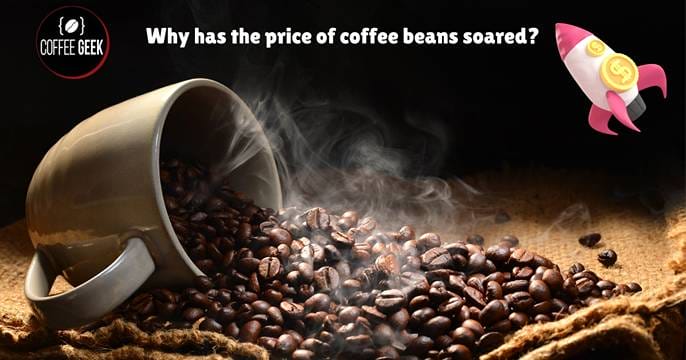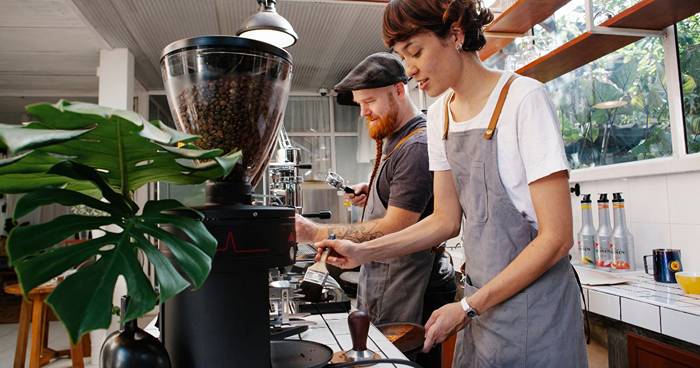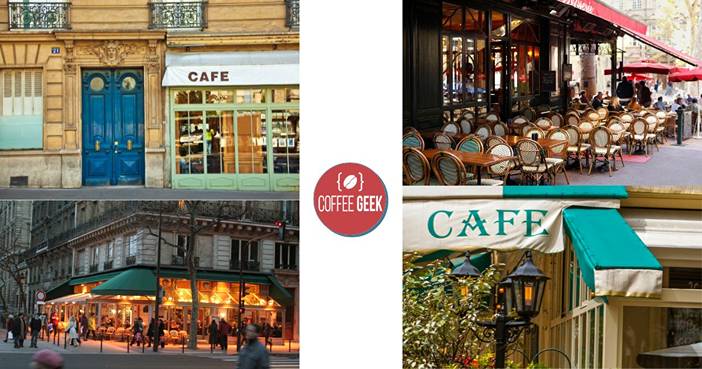Are you a coffee lover wondering, “why is coffee so expensive?” Well, we endeavor to break down the increasingly higher prices of your favorite morning coffee in this article.
We will delve deep into the world of coffee pricing – from the nearby coffee farms to your preferred coffee shop.
Why is Coffee So Expensive?

The price of coffee beans has started to soar due to several factors that influence both the coffee industry and the global food and drink industry. Let’s look at these factors in detail.
The Impact of the Coffee Harvest on Prices
The coffee harvest has a significant impact on the price of coffee.
Poor harvest seasons can lead to a decline in the amount of coffee, causing prices to rise. Measures to protect coffee plants from pests and diseases also contribute to high prices.

Supply Chain Disruption and Coffee Price Increases
The coffee supply chain, from the coffee farm to your local coffee store, has been greatly impacted by recent global events.
These disruptions have caused the cost of coffee to increase further, making coffee drinks from specialty coffee to your basic drip coffee, even more of a luxury in 2022.
The Role of Coffee-Exporting Countries
Coffee-exporting countries play a crucial role in the price of beans. Economic instability, policy changes, and export taxes in these regions can result in higher coffee prices globally.
Factors Contributing to the Cost of Coffee
| Factors | Description |
|---|---|
| 1. Geographic Origin | Coffee beans are predominantly grown in specific regions around the world, often at high altitudes and in remote areas. Transportation costs, accessibility, and climate conditions can impact the overall expense of cultivation. |
| 2. Labour Intensive Cultivation | Coffee cultivation and harvesting require significant manual labor, particularly for specialty coffee varieties. The need for skilled workers, handpicking of ripe cherries, and careful processing contribute to higher labor costs. |
| 3. Climate Sensitivity | Coffee plants are highly sensitive to climate conditions. Adverse weather events, such as droughts or excessive rainfall, can negatively affect crop yields. This vulnerability increases the risk for coffee farmers, influencing the market price. |
| 4. Specialty Coffee Production | The production of high-quality, specialty coffee involves meticulous processes, including selective harvesting, careful drying, and rigorous quality control. These extra steps contribute to higher production costs and, consequently, a higher retail price. |
| 5. Certification and Sustainability | Many coffee producers adhere to certifications for fair trade, organic, or sustainable practices. These certifications often involve additional expenses and compliance costs, which are reflected in the final price of the coffee. |
| 6. Fluctuating Exchange Rates | Coffee is a globally traded commodity, and its price is influenced by currency exchange rates. Fluctuations in the currency market can impact the cost of importing and exporting coffee, affecting the final retail price. |
| 7. Processing and Roasting | The processing and roasting of coffee beans require specialized equipment and skilled labor. The use of advanced technology, energy consumption, and the level of expertise in roasting contribute to the overall cost of the final product. |
| 8. Supply Chain Complexity | The coffee supply chain is complex, involving multiple intermediaries, including farmers, processors, exporters, importers, and retailers. Each step adds costs, and the final retail price reflects the cumulative expenses incurred throughout the supply chain. |
| 9. Market Demand and Speculation | High demand for specialty and premium coffees can drive up prices. Additionally, speculation in the commodities market can impact the cost of raw coffee beans, influencing the final retail price for consumers. |
| 10. Economic and Political Factors | Economic conditions and political stability in coffee-producing countries can impact production and distribution. Instability or economic challenges may disrupt the supply chain and contribute to increased prices. |
Why is Getting Coffee at Starbucks or Other Coffee Shops so Expensive?
The increasing cost of a cup of joe is also evident in larger coffee companies like Starbucks, and we’ll explain why.
The Reality of Higher Starbucks Prices in 2022-2023
Higher prices in 2022 and projections for 2023 are reflective of the broader industry. Costs of raw materials, such as quality coffee beans, have gone up, necessitating a hike in the price of your favorite caffeinated latte or cold brew.

The ‘Latte Factor’: An Exploration of Premium Coffee Charges
The ‘Latte Factor’, referring to the habitual spending on a cup of specialty coffee, plays a part in why coffee is so expensive.
Premium coffee charges, for that perfectly brewed espresso, can add up, contributing to your perception of getting more expensive.
What You Pay for When You Order an Espresso at the Coffee Shop
When you order an espresso or any other coffee at your local shop, you are not just paying for the drink.
The coffee price includes the wages of the baristas, rent of the cafe, and other overhead costs that the coffee shop owner incurs.
How Labor Costs Contribute to the Soaring Price of Our Favorite Brew
Human resources is an integral part of the coffee industry, and rising labor costs can contribute to your coffee being more expensive.
The Integral Role of Baristas in your Cafe Experience
When you visit a cafe, the barista brewing the perfect cup adds value to your coffee experience. Baristas are trained coffee professionals, and their wages add to the higher coffee prices.

Understanding Employees’ Wages in the Coffee Industry Pricing
From the coffee farmers taking care of the coffee plants to the baristas brewing your coffee, employee wages across the coffee supply chain significantly impact the final cost of coffee.
The Hidden Labor Behind Your Coffee Beans

There is also hidden labor behind your coffee beans.
This includes the farmworkers who handpick the beans, the producers who carefully roast them, and the drivers who transport them – all contributing to why coffee is so expensive.
The Hidden Cost in a Coffee Shop Business: Rent and Utilities
Beyond the visible costs such as labor and coffee beans, renting space and paying for utilities also feed into your café latte price.
How the Location of Your Local Coffee Shop Affects Your Coffee Price
The location of your favorite coffee shop can greatly impact the coffee price. Shops situated in prime areas may charge higher costs to cover their steep rents.

Utility Costs in Brewing Your Drip Coffee
Utility costs, such as water and electricity used in making your coffee, are a part of the cost of coffee.
The Weight of Rent in Your Cafe’s Latte Price
Additionally, higher rent to provide an enjoyable ambiance for coffee drinkers greatly adds to the coffee costs.
Why is Making Coffee at Home Becoming More Expensive Too?
Unfortunately, even making certain amount of coffee at home is not immune to price hikes.
Inflation and Its Impact on Your Home Brew Cost
Inflation has a noticeable effect on your home brew costs. From the price of beans to milk and sugar, every ingredient of your home-made coffee has experienced a spike due to inflation.

Exploring the Rise of Coffee Essentials: Milk, Sugar, and Filters
Rising price of essentials items such as milk, sugar, and coffee filters, necessary for making coffee at home, also contribute to the reason coffee at home is becoming costly.
Is there such a thing as free coffee in 2022?
Given all these raising prices, the prospect of a free cup of joe seems far-fetched. Yet, many coffee businesses often offer deals and loyalty programs to help offset the prices for coffee lovers.
So while it may not be entirely free, there are still ways to enjoy quality coffee without breaking the bank.
People Also Ask
Why has coffee gotten so expensive recently?
The price hike in coffee can be attributed to several factors like increased production costs, labor costs among other factors. Even factors like rent and tariffs can contribute to it.
It also means higher expenses for the coffee producers and thus, we’re paying more for our coffee.
Are there specific coffee needs that have led to it getting more expensive?
A: Yes, definitely. The demand for smaller, single-origin coffee and niche cold brew coffee varieties, among other types of coffee is on the rise, requiring the coffee producers to adapt, which in turn can cause a price increase.
Are we paying more for coffee due to the increased amount of coffee we’re consuming at home?
Partially. With more people brewing coffee at home, especially due to the pandemic, the demand for coffee beans, coffee filters, and coffee and brewing equipment has increased, thus inflating the price.
It’s a simple equation of supply and demand.
Does the type of coffee includes in the rise of its price?
Yes, indeed. The cost of an average flat white, cappuccino, americano, 7 latte, cold brew, milk latte, or oat milk coffee have seen a spike in their costs recently due to a number of factors.
These factors could be anything from the quality of beans used, the brewing technique, and even the type of milk used, among other factors.
Why does smaller coffee cost more?
Smaller coffee often represents single-origin or specialty coffee, which means the beans come from one specific location and are of a higher quality.
These beans are more expensive to produce and thus reflect in the price of coffee.
Does the process of coffee and brewing also contribute to its high cost?
Absolutely! The process of sourcing beans, roasting them at the roaster, grinding them, and then brewing them, particularly using an espresso machine, requires a lot of resources, time, and skill.
This also contributes to the price you pay for coffee, whether you’re getting it as a takeaway or preparing it at home.
How does the rise in coffee prices affect coffee producers in central and south america?
The rise in coffee prices does not necessarily mean that coffee producers in Central and South America are getting wealthier.
They’re facing rising costs in many areas that they operate in, including Starbucks and other major retailers. In some cases, the price they receive per pound may not even cover their operating costs.
Does the cost of an average cup of coffee vary from place to place?
Yes, the price of a cup of coffee can vary significantly depending on where you purchase it.
For example, the price of a pound of coffee in a rural cafe might be a lot less than what you’d pay in a city cafe due to factors like rent and cost of ingredients, among other factors.
I remember coffee being a lot cheaper, even thinking back a few years. Why is this?
The main reasons of the rising costs are because of prices boost and cost increases in the production of coffee. This includes the cost of labor, equipment, soil, climate change effects, and even marketing costs.
Another factor, there’s also the fact that consumers are gravitating towards pricier, high-quality coffees, thus pushing the average price up.
Can we expect coffee to get even more expensive?
It’s hard to say.
While there are fluctuations in the market and the price of beans due to factors like weather conditions in the tropics, demand, new rituals like using oat milk or almond milk instead of traditional milk, and other parameters, coffee prices could continue to fluctuate.
In any case, the love for coffee doesn’t seem to be lessening – even if it’s a bit harsher on the wallet!

